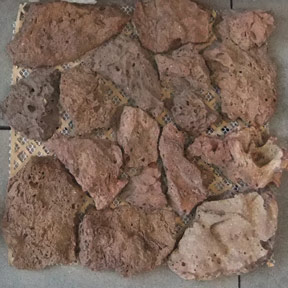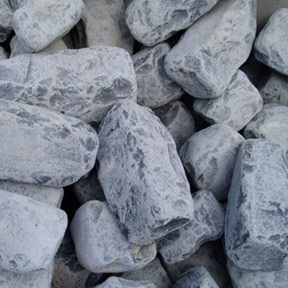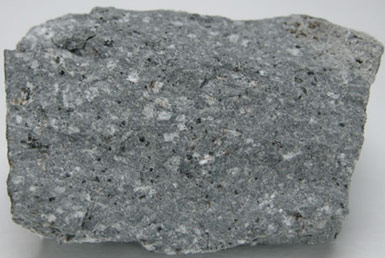E: export@newstarchina.com
P: +86-595-2228 9926
F: +86-595-2228 7926
 Lava is molten rock expelled by a volcano during an eruption. When first expelled from a volcanic vent, it is a liquid at temperatures from 700 °C to 1,200 °C (1,300 °F to 2,200 °F). Although lava is quite viscous, with about 100,000 times the viscosity of water, it can flow great distances before cooling and solidifying, because of both its thixotropic and shear thinning properties.[1][2] A lava flow is a moving outpouring of lava, which is created during a non-explosive effusive eruption. When it has stopped moving, lava solidifies to form igneous rock. The term lava flow is commonly shortened to lava. Explosive eruptions produce a mixture of volcanic ash and other fragments called tephra, rather than lava flows. The word 'lava' comes from Italian, and is probably derived from the Latin word labes which means a fall or slide.[3][4] The first use in connection with extruded magma (molten rock below the earth's surface) was apparently in a short account written by Francesco Serao on the eruption of Vesuvius between May 14 and June 4, 1737.[5] Serao described "a flow of fiery lava" as an analogy to the flow of water and mud down the flanks of the volcano following heavy rain.
Lava is molten rock expelled by a volcano during an eruption. When first expelled from a volcanic vent, it is a liquid at temperatures from 700 °C to 1,200 °C (1,300 °F to 2,200 °F). Although lava is quite viscous, with about 100,000 times the viscosity of water, it can flow great distances before cooling and solidifying, because of both its thixotropic and shear thinning properties.[1][2] A lava flow is a moving outpouring of lava, which is created during a non-explosive effusive eruption. When it has stopped moving, lava solidifies to form igneous rock. The term lava flow is commonly shortened to lava. Explosive eruptions produce a mixture of volcanic ash and other fragments called tephra, rather than lava flows. The word 'lava' comes from Italian, and is probably derived from the Latin word labes which means a fall or slide.[3][4] The first use in connection with extruded magma (molten rock below the earth's surface) was apparently in a short account written by Francesco Serao on the eruption of Vesuvius between May 14 and June 4, 1737.[5] Serao described "a flow of fiery lava" as an analogy to the flow of water and mud down the flanks of the volcano following heavy rain.
 Basalt is a common extrusive volcanic rock. It is usually grey to black and fine-grained due to rapid cooling of lava at the surface of a planet. It may be porphyritic containing larger crystals in a fine matrix, or vesicular, or frothy scoria. Unweathered basalt is black or grey. The most common uses for this rock are as aggregate in highway construction, railroad ballast, and tile. Basalt is also a major component of asphalt. On Earth, most basalt magmas have formed by decompression melting of the mantle. Basalt has also formed on Earth's Moon, Mars, Venus, and even on the asteroid Vesta. Source rocks for the partial melts probably include both peridotite and pyroxenite (e.g., Sobolev et al., 2007). The crustal portions of oceanic tectonic plates are composed predominantly of basalt, produced from upwelling mantle below ocean ridges. The term basalt is at times applied to shallow intrusive rocks with a composition typical of basalt, but rocks of this composition with a phaneritic (coarse) groundmass are generally referred to as dolerite (also called diabase) or gabbro.
Basalt is a common extrusive volcanic rock. It is usually grey to black and fine-grained due to rapid cooling of lava at the surface of a planet. It may be porphyritic containing larger crystals in a fine matrix, or vesicular, or frothy scoria. Unweathered basalt is black or grey. The most common uses for this rock are as aggregate in highway construction, railroad ballast, and tile. Basalt is also a major component of asphalt. On Earth, most basalt magmas have formed by decompression melting of the mantle. Basalt has also formed on Earth's Moon, Mars, Venus, and even on the asteroid Vesta. Source rocks for the partial melts probably include both peridotite and pyroxenite (e.g., Sobolev et al., 2007). The crustal portions of oceanic tectonic plates are composed predominantly of basalt, produced from upwelling mantle below ocean ridges. The term basalt is at times applied to shallow intrusive rocks with a composition typical of basalt, but rocks of this composition with a phaneritic (coarse) groundmass are generally referred to as dolerite (also called diabase) or gabbro.
 Andesite is an extrusive igneous, volcanic rock, of intermediate composition, with aphanitic to porphyritic texture. In a general sense, it is the intermediate type between basalt and dacite. The mineral assemblage is typically dominated by plagioclase plus pyroxene and/or hornblende. Magnetite, zircon, apatite, ilmenite, biotite, and garnet are common accessory minerals.[1] Alkali feldspar may be present in minor amounts. The quartz-feldspar abundances in andesite and other volcanic rocks are illustrated in QAPF diagrams. Relative alkali and silica contents are illustrated in TAS diagrams.
Andesite is an extrusive igneous, volcanic rock, of intermediate composition, with aphanitic to porphyritic texture. In a general sense, it is the intermediate type between basalt and dacite. The mineral assemblage is typically dominated by plagioclase plus pyroxene and/or hornblende. Magnetite, zircon, apatite, ilmenite, biotite, and garnet are common accessory minerals.[1] Alkali feldspar may be present in minor amounts. The quartz-feldspar abundances in andesite and other volcanic rocks are illustrated in QAPF diagrams. Relative alkali and silica contents are illustrated in TAS diagrams.